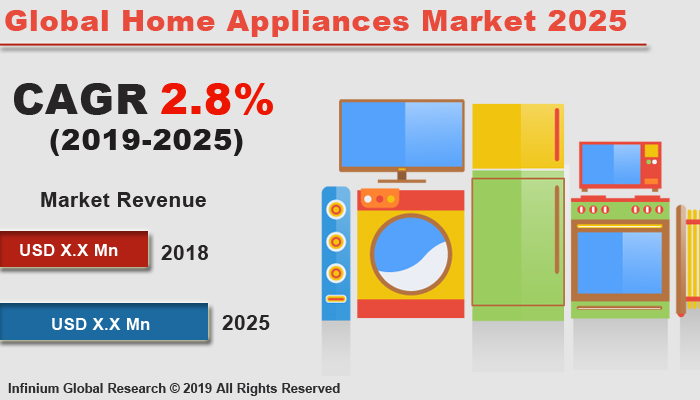Home Appliances Market (Product - Kitchen Appliances, Washing Appliances, Entertainment Appliances, Air Conditioner, and Others; Distribution Channel - E-commerce, Retail, and Others; Technology - Wi-Fi, Bluetooth, Zigbee, Radio Frequency Identification, Cellular Technology, and IoT): Global Industry Analysis, Trends, Size, Share and Forecasts to 2025
A recent report published by
Infinium Global Research on the home appliances market provides an in-depth
analysis of segments and sub-segments in the global as well as regional home
appliances market. The study also highlights the impact of drivers, restraints,
and macro indicators on the global and regional home appliances market over the
short term as well as long term. The report is a comprehensive presentation of
trends, forecast and dollar values of the global home appliances market.
According to the report, the global home appliances market is projected to grow
at a CAGR of 2.8% over the forecast period of 2019-2025.

Market Insight
The home appliance industry
comprises electrical or mechanical devices used in a household. Smart
appliances offer advanced features and are more energy-efficient. Home
appliances mainly include air conditioners, refrigerators, and freezers, coffee
machines, heaters, recording devices, television and washing machines/ dryers.
Buying new home appliances isn’t always as affordable. New Energy Star
applications typically need less maintenance than standard models do. The
consumption of energy-efficient appliances leads to reduced consumption of
energy that automatically translates to savings on electricity bills. An Energy
Star appliance saves 30% on electricity costs. According to the U.S.
Environmental Protection Agency (EPA), one can reduce greenhouse gas emissions
by up to 130,000 pounds over the lifetime of efficient appliances.
With the growing middle-class
economy, the home appliances market is undergoing steady growth along with the
availability of a wide range of home appliances at a competitive price. These
are the primary factors driving the growth of the home appliances market.
Consumers extensively purchase home appliances as they provide suitability,
reduce manual efforts and save time. Moreover, with increasing digitalization,
consumers have become tech-savvy and have strong knowledge regarding the use
and benefits of all modern appliances. The emergence of smart homes is supporting
the proliferation of smart appliances that can be connected to the end user's
smartphone and monitored remotely. This, in turn, is strengthening the growth
of the home appliances market. Furthermore, Use of connectivity as a
distinguishing feature by manufacturer’s Wireless technologies such as Wi-Fi,
Bluetooth and ZigBee are accessed by smartphones and tablets. Therefore,
consumers are easily opting for wireless and technologically advanced products.
This, in turn, has opened several doors of opportunity for the key players in
the global home appliances market. Low cost related to the proprietorship of
white goods, predominantly in developing economies also provides opportunities
for market growth. The market is significantly driven by inclinations such as
effectiveness, diversity, sustainability and elegant design and smart
functionality of home appliances. Product innovation, new product development,
product differentiation and integration of numerous value-added features in
appliances are further expected to project the home appliances market demand
over the next few years.
Among the geographies, Asia
Pacific dominated the global home appliances market. The growth in the Asia Pacific
region is due to owing to the rising energy and greater awareness about smart
cities and smart integrated appliances. Moreover, in developed countries, the
demand for smart connected kitchen appliances are gaining traction owing to
early technology adopters. Only a few vendors such as LG Electronics and
Samsung Electronics have paved their way into the smartly connected
refrigerator space, with product offerings largely targeted at the developed
markets. Financial expansion in countries such as China and India is
anticipated to boost the home appliances market demand. Growing population,
rapid infrastructure development, and strong economic development are also
expected to positively influence market growth over the forecast period.
In 2018, Whirlpool Corporation is
expanding its smart home appliance ecosystem this year with the announcement of
a collaboration with Honeywell. Consumers will now be able to connect smart
appliances from Whirlpool Corporation to Honeywell’s line of connected
thermostats, allowing for remote management of their appliance operating modes
and energy outputs.
Segment Covered
The report on the global home
appliances market covers segments such as product, distribution channel,
application, and technology. On the basis of product, the sub-markets include
kitchen appliances, washing appliances, entertainment appliances, air conditioner,
and others. On the basis of the distribution channel, the sub-markets include
e-commerce, retail, and others. On the basis of technology, the sub-markets
include Wi-Fi, Bluetooth, ZigBee, radio frequency identification, cellular
technology, and IoT.
Companies Profiled:
The report provides profiles of
the companies in the market such as SAMSUNG, Whirlpool Corporation, Panasonic
Corporation, Midea Group., LG Electronics., V-ZUG Ltd, Newell Brands, Haier
Inc, Electrolux, and De’Longhi Appliances S.r.l.
Report Highlights:
The report provides deep insights
into the demand forecasts, market trends, and micro and macro indicators. In
addition, this report provides insights into the factors that are driving and
restraining the growth in this market. Moreover, The IGR-Growth Matrix analysis
given in the report brings an insight into the investment areas that existing
or new market players can consider. The report provides insights into the
market using analytical tools such as Porter's five forces analysis and DRO
analysis of the home appliances market. Moreover, the study highlights current
market trends and provides forecast from 2019-2025. We also have highlighted
future trends in the market that will affect the demand during the forecast
period. Moreover, the competitive analysis given in each regional market brings
an insight into the market share of the leading players.
Please Choose One of them.